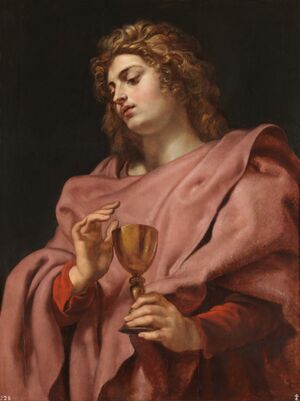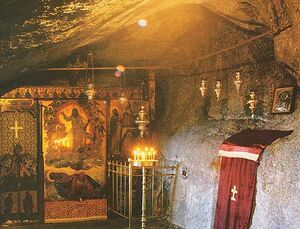João Evangelista

João Evangelista foi o discípulo que conviveu mais intimamente com Jesus Cristo. Ele é o autor do Livro do Apocalipse, ditado por Jesus, “enviado e notificado pelo seu anjo”. Além de ser o que melhor assimilou os ensinamentos místicos do Cristo, João também foi o único dos doze apóstolos a ascender naquela vida.
Suas vidas na Terra
Sob a tutela de José, protetor de Maria e de Jesus, João e o seu irmão Tiago foram treinados na comunidade essênia. Ao contemplar Jesus entrando no templo interior enquanto orava externamente, João percebeu o destino do Cristo. Anos depois, quando recebeu o chamado, João estava pronto para seguir o seu Senhor e o seu Mestre.
João também era o discípulo que melhor magnetizava o raio do amor. E expressou o amor que sentia, não apenas por Jesus, mas também pela luz do seu Cristo interior e pela própria missão que ele, acima de tudo, compreendeu e compartilhou. O discípulo conta que nutria um amor tão imenso por Jesus que, para ascender, precisou aprender o significado do amor impessoal.
João foi o único discípulo que não abandonou Jesus, enquanto ele morria na cruz. “Vendo Jesus ali a sua mãe, e que o discípulo a quem ele amava estava presente, disse a sua mãe: ‘Mulher, eis o teu filho’. Depois disse ao discípulo: ‘Eis a tua mãe’”.[1] Assim, Jesus reconheceu João como o irmão espiritual que era digno de ser filho da sua própria mãe, e elevou-o ao nível do Cristo.
João encarnou integralmente o Cristo Pessoal. Se assim não fosse, Jesus não teria estabelecido o relacionamento entre o discípulo e a sua mãe, pois, no sentido arquetípico da Mãe Universal, Maria encarnava aquela chama. Quando Jesus lhe disse que João era seu filho, não falava apenas no sentido físico, mas no universal, João era Filho de Deus e da Mãe Divina, a quem Maria representava.

John stayed in Jerusalem for some time during the persecutions following Jesus’ resurrection. After the martyrdom of Peter and Paul, John settled in Ephesus, the greatest city of Asia Minor, where Paul had centered his missionary activities. There is a tradition, which is confirmed by Tertullian and Jerome, that during the reign of Domitian, John was taken to Rome where an attempt to put him to death in a cauldron of boiling oil was miraculously thwarted. (This is the test of fire that was also faced by Shadrach, Meshach and Abednego.[2]) He emerged from the cauldron unharmed and was then banished to the island of Patmos. Here he received and recorded the Book of Revelation.
After the death of Domitian in the year A.D. 96, John could return to Ephesus, and many believe that he wrote his Gospel and three epistles at that time, when he was in his nineties. John is said to have passed his last years at Ephesus, and to have died there at a great age, outliving all the other apostles. According to some, he simply “disappeared”—was translated like Elijah or “assumed” into heaven as was the Blessed Virgin. Others testify to the miracles wrought from the dust of his tomb.
In an earlier embodiment, John was Benjamin, the youngest brother of Joseph, the idle dreamer, who later embodied as Jesus. Of his eleven brothers (all of whom served as his disciples in his final embodiment), Joseph loved Benjamin the most.
His service today
John uses as his symbol a purple Maltese Cross superimposed upon a pink Maltese Cross with gold radiance surrounding it. The flame focused in his retreat in the etheric realms above the state of Arizona is purple and gold. Through this flame, which focuses the power of divine love in its four phases, he teaches the mastery of fire, air, water and earth as the four aspects of the nature of God.
This hope is also held by beloved John and the brothers and sisters who serve in his retreat, who teach the impersonal impersonality of divine love through the mastery of the fire element, the impersonal personality of divine love through the mastery of the air element, the personal personality of divine love through the mastery of the water element, and the personal impersonality of divine love through the mastery of the earth element. (These four aspects of God’s consciousness correspond to God as Father, Son, Mother and Holy Spirit.)
Students who desire to study these four aspects of the nature of God and how they can solve the problems of our civilization that are the result of the perversions of the love ray on the planet may ask to be taken to John the Beloved’s retreat while they sleep.
See also
Angel of the Revelation of John the Divine
Sources
Mark L. Prophet and Elizabeth Clare Prophet, The Masters and Their Retreats, s.v. “John the Beloved.”
